Was the Civil War caused by states' rights or slavery?
Enslavement was the most divisive issue the United States has ever faced and it led to a bitter Civil War. The early political conflicts were not about slavery in the South but its extension as new states joined the Union. The Missouri Compromise of 1820 established an east-west line along the southern border of Missouri that its supporters hoped would forever divide free and slave settlement. States to the south could allow slavery; states to the north (with the exception of slave state Missouri) could not.
Iowa: A Free but Complicit State to Slavery
Settlers knew that Iowa would be a free state. Most Iowans of the time were willing to let slavery exist in the South. Like most white Americans of the time period, they believed in the superiority of the white race and opposed granting equal rights or opportunities to African Americans. They passed laws attempting to discourage blacks from coming to the state. On the national level, they wanted most of all to find compromises that would keep the Union together. Iowa did have a small population of abolitionists who wanted to abolish slavery everywhere as a moral evil.
In 1854, Congress passed the Kansas-Nebraska Act that allowed the settlers in any new territory to decide the slavery issue there for themselves. This opened the possibility that Nebraska on Iowa’s western border could become a slave state. Most Iowans opposed that prospect. The Republican Party emerged strongly opposed to any further extension of slavery into western territories.
The Election of Abraham Lincoln and the Dawn of the Civil War
In 1860, Republican candidate Abraham Lincoln was elected president. Several southern states seceded (withdrew) from the Union, formed the Confederate States of America, and took over federal forts and other buildings. In April, southern cannons opened fire on Ft. Sumter in the harbor of Charleston, South Carolina, and the Civil War began.
Lincoln called for 75,000 volunteers to enlist for three months to put down the rebellion. Iowa quickly exceeded its quota. The war did not end quickly, as most expected and hoped, but instead dragged on for four very bloody years. Iowa soldiers fought mainly in the western battles, including Shiloh and Vicksburg. Disease took a fearful toll on the troops. By the end of the war, 3,000 Iowa soldiers had been killed and around 8,000 had died from diseases.
Women Take Charge of the Home Front
On the home front, women had to shoulder the workloads of husbands, brothers and sons who had left to fight. Their burdens were especially heavy on the farms. Women also organized to provide the troops with clothing, food and medical supplies. Annie Wittenmyer of Keokuk became a national leader in improving conditions for the sick and wounded in Union hospitals. General Grenville Dodge proved his skill as a railroad builder and created an efficient spy network.
The war had a huge impact on the political landscape. After Southern surrender in 1865, the state became strongly Republican. Democrats were tarred as the party of the South. A constitutional amendment in 1868 granted the right to vote to African-American men, though women could not vote until 1920. Memories of the war would be strong for the next half century. The Union was preserved.
Supporting Questions
North vs South: Who thought they were right?
How was slavery and the extension of it reflected as a cause of conflict?
- Petitions from Iowa Recorded in the U.S. Senate Journal, between 1850 and 1864 (Document)
- "The Great Exhibition of 1860" Political Cartoon, 1860 (Image)
- Alexander Hamilton Stephens' Papers, January 10 to February 14, 1861 (Document)
How did Southerners justify secession?
- "The North the Aggressor - - - The South on the Defensive" Newspaper Article, October 4, 1860 (Document)
- "We Are Out of the Union" Newspaper Article, January 3, 1861 (Document)
- Constitution of the Confederate States of America, 1861 (Document)
- "The Dis-United States. Or the Southern Confederacy" Cartoon, 1861 (Image)
What factors contributed to conflict between North and South?
- "The Hurly-Burly Pot" Cartoon, 1850 (Image)
- "The Hercules of the Union, Slaying the Great Dragon of Secession" Cartoon, 1861 (Image)
- President Abraham Lincoln’s First Inaugural Address, March 4, 1861 (Document)
| Civil War Source Set Teaching Guide |
| Printable Image and Document Guide |
"Cornerstone Speech" by Alexander Stephens in Savannah, Georgia, March 21, 1861

Description
Alexander Hamilton Stephens, vice president of the Confederate States of America, gave this speech on March 21, 1861 to justify secession. Stephens' speech declared that disagreements over the enslavement of Africans was the "immediate cause" of secession.
Petitions from Iowa Recorded in the U.S. Senate Journal, between 1850 and 1864
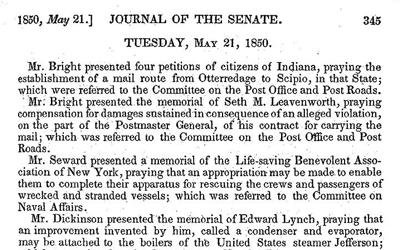
Description
The Journal of the U.S. Senate of the United States is a record of all proceedings in the chamber. Throughout the decade leading up to the Civil War, members of Iowa’s congressional delegation presented petitions from the state regarding slavery.
"The Great Exhibition of 1860" Political Cartoon, 1860
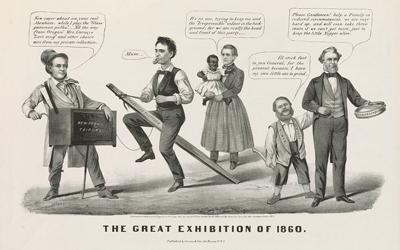
Description
The artist satirizes the antislavery orientation of the Republican platform. Abolitionist editor Horace Greeley (left) grinds his New York "Tribune" organ as candidate Abraham Lincoln (center, riding on a wooden rail) prances to the music. Lincoln is tethered with a…
Alexander Hamilton Stephens' Papers, January 10 to February 14, 1861
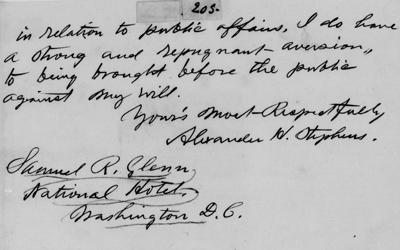
Description
This letter was written by Alexander Hamilton Stephens, who was the vice president of the Confederate States of America. Stephens wrote the letter to Samuel R. Glenn on leaving it to the historians to explain the causes of the war. He wrote the letter on February 8,…
"The North the Aggressor - - - The South on the Defensive" Newspaper Article, October 4, 1860
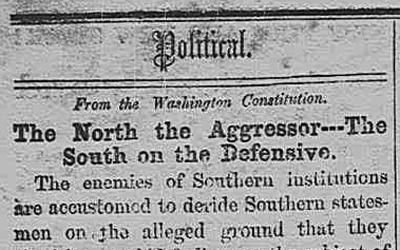
Description
The newspaper article from the Anderson Intelligencer was published in South Carolina in October 1860. This was roughly a month before the presidential election and ultimately said that "the South will not submit to a diminution of its rights."
"We Are Out of the Union" Newspaper Article, January 3, 1861

Description
This newspaper article appeared in Yorkville, South Carolina, in January, 1861 shortly after South Carolina seceded. The tone of the article is celebrating South Carolina's secession as it was "no longer under the dominion of the North." The author of the article…
Constitution of the Confederate States of America, 1861

Description
The provisional Constitution of the Confederate States of America was written when southern states first seceded from the Union. It is, in large part, exactly the same as the U.S. Constitution, with notable exceptions, some of which are excerpted here. They predominantly…
"The Dis-United States. Or the Southern Confederacy" Cartoon, 1861
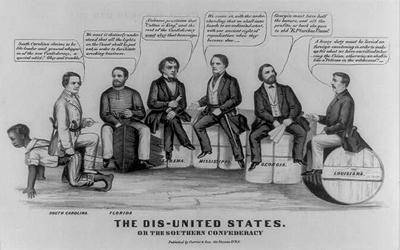
Description
In this cartoon, the Confederate leaders are portrayed as a band of competing opportunists led by South Carolina governor and secessionist Francis Pickens (far left). The artist criticizes the January 1861 secession of five states from the lower south, following the lead of…
"The Hurly-Burly Pot" Cartoon, 1850
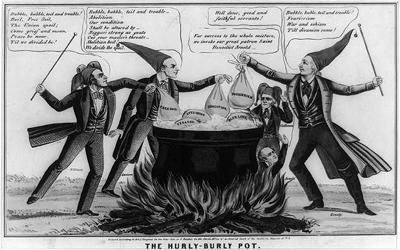
Description
This cartoon was created to attack abolitionist, Free Soil, and other sectionalist interests of 1850 as dangers to the Union. The artist, James Baillie, singles out for indictment radical abolitionist William Lloyd Garrison, Pennsylvania Free Soil advocate David…
"The Hercules of the Union, Slaying the Great Dragon of Secession" Cartoon, 1861
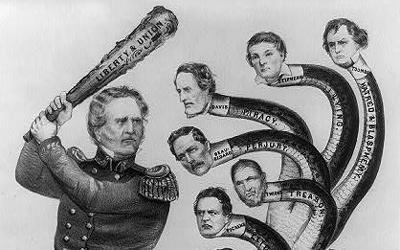
Description
This cartoon from 1861 shows General Winfield Scott slaying a dragon called secession. The cartoon serves as a tribute to the commander of Union forces, Gen. Winfield Scott, shown as the mythical Hercules slaying the many-headed dragon or hydra, here symbolizing…
President Abraham Lincoln’s First Inaugural Address, March 4, 1861

Description
Abraham Lincoln, in his first inaugural address, focused on shoring up his support in the north without further alienating the south, where he was almost universally hated or feared. Delivered after Hannibal Hamlin was sworn in as vice president, the…
Additional Resources:
- An Anxious Christmas Eve
A diary entry by Benjamin Tucker Tanner, who was a powerful church leader and later, a bishop in the African Methodist Episcopal Church. Tanner’s entry rejoiced the approach of Christmas in 1860, but also expressed worry over the state of the country as the nation was on the brink of civil war. He described the decisive issue as slavery. - The Life of James W. Grimes
The book contains primary source records of Grimes, who served as both a governor of Iowa and a U.S. senator. Notably, the book contains his address to the General Assembly when he became governor in 1854.
Iowa Core Social Studies Standards (8th Grade)
Listed below are the Iowa Core Social Studies content anchor standards that are best reflected in this source set. The content standards applied to this set are middle school-age level and encompass the key disciplines that make up social studies for eighth grade students.
| No. | Standard Description |
| SS.8.13. | Explain the powers and responsibilities of citizens, political parties, and the media in a variety of governmental and nongovernmental contexts. (21st century skills) |
| SS.8.21. | Analyze connections among early American historical events and developments in broader historical contexts. |
| SS.8.22. | Explain how how and why prevailing social, cultural, and political perspectives changed during early American history. |
| SS.8.23. | Explain multiple causes and effects and developments in early American history. |
| SS.8.24. | Critique primary and secondary sources of information with attention to the source of the document, its context, accuracy, and usefulness such as the Declaration of Independence, the Bill of Rights, the Constitution, Washington's Farewell address, the Louisiana Purchase treaty, Monroe Doctrine, Indian Removal Act, Missouri Compromise, Dred Scott v. Sanford, and the Treaty of Guadalupe-Hidalgo. |